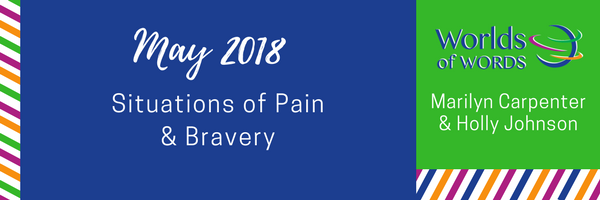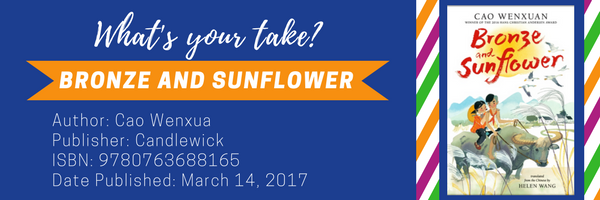
This month we discuss books that present situations of pain and bravery as young people learn to negotiate the difficulties of life while still quite young. As part of their negotiations, they learn about love and the lengths people will go through to keep loved ones safe. Each book offers surprises and perhaps a bit of controversy. Each is thought-provoking and worthy of our reading time. Our first book is Bronze and Sunflower by Cao Wenxuan and illustrated by Meilo So.

MARILYN: Bronze and Sunflower was recently translated from Chinese into English by Helen Wang. Wenxuan is a popular author for children in China and a philosophy professor at Peking University. I heard him speak and was inspired! The story is set during the Cultural Revolution in China. Sunflower, a 7-year-old girl, travels with her father, a famous sculptor of bronze sunflowers, when he is sent to a rural Cadre School to be “re- educated.” He has little time for Sunflower, who is lonely and on her own most of the time. She eventually makes friends with Bronze, a mute boy living in a village across the river. When her father drowns she is taken in by Bronze’s family even though they are poor. The family makes a tremendous effort to send her to school where she thrives. Her schooling benefits Bronze when Sunflower teaches him to read and write. There are several heart-tugging episodes in a setting that is vital and important in the story. In a way this novel provides a respite from the problem novels I have been reading, stories of American children dealing with the challenges of our modern world. Even though there are many challenges that the Chinese characters must surmount, hard work, family love, grit and determination make the difference for them. I am eager to read what you think about the book, Holly.
HOLLY: While reading this book, I kept thinking about the theme of interdependence. Families are interdependent, but I wonder how often people think about the family unit in that way. Sunflower needs her adopted family to stay alive, but what do they get from her? Over and over she thinks about how she doesn’t do anything for the family, but maybe it is happiness? Then again, she might also bring them prestige since she is a city girl. This is especially true with respect to Bronze, who had been lonely before Sunflower comes into his life.
Other thoughts that come to me are how this book parallels the Cultural Revolution in China. Readers have little idea of Sunflower’s life prior to the Cultural Revolution, which creates hardships for many artistic and academic groups, who are then forced to work the land in cadres of hard labor. Sunflower’s life is embedded in hardship, first at the Cadre School with her father, and then when she joins the poorest family in the village of Damaidi. Once the Cultural Revolution is over, which is only alluded to by the request of the “city” people to have Sunflower return, Sunflower’s life would improve and she would be honored as part of her artistic father’s legacy. But, I have a difficult time with the gentle telling of such hardship, so wonder, who is the audience of this book, and how would I use it?
Ultimately, this book not only gives readers a sense of the historical and geographical setting of a rural village in China in the 1960s/1970s, but the episodes are reminiscent of small communities and young children around the world. That universal aspect of the narrative is especially engaging. In a number of ways, Bronze and Sunflower connects to the books, The Hired Girl (2015) by Laura Amy Schlitz and Armstrong and Charlie (2017) by Steven B. Frank, both of which we discuss in the next couple of weeks. The hard part of the book is the end. What a heartbreaking way to leave the reader. But very Hans Christian Anderson, which is one of the awards Cao Wenxuan won. What did you think?
MARILYN: I saw the ending of the book as not heartbreaking, but triumphant. All through the novel, Bronze’s family makes sacrifices for Sunflower. The reason they do this is that her friendship and kindnesses to Bronze makes a huge difference in his life, also because they see her promise. For the first time Bronze had a friend. Before meeting Sunflower, he is bullied and ostracized by the villagers. Sunflower brings him friendship and companionship. And, she teaches him the lessons she learns in school. He deeply grieves over her loss when she moves to the city to continue her education. But in the end he finds his voice. Perhaps he will be allowed to attend the village school for the first time. I would like to read a sequel. This book needs to be read aloud in classrooms. It would make a big impact on the students’ understanding of China and the value of friendship.
HOLLY: I appreciate your rosy-colored view of this novel, Marilyn! I cannot imagine what it would be like to first lose both of your parents by the time you are 8-years-old, then be abandoned by the other adults in your life only to live a life of deep poverty, and then once you have adjusted, to be moved away from the family who adopted, loved and sustained you. This book presents a philosophy of children as commodities, as elements of the larger regime who have no agency in respect to their own lives. It would make an interesting read aloud with middle school students if framed as a narrative that examines agency and national roles in individual lives. If not framed this way, while a sweet book on one level, it is still disturbing on other levels. I am not sure I could recommend it for an independent read.
Editor’s Note: To read additional views on this book see August 2017 MTYT where the reviewers examined Rethinking Conceptual Otherness in History. Bronze and Sunflower is also the WOW Recommends: Book of the month for December 2017.
Title: Bronze and Sunflower
Author: Cao Wenxua
Publisher: Candlewick
ISBN: 9780763688165
Date Published: March 14, 2017
This is the first installment of May 2018’s My Take/Your Take. To follow the whole conversation, check back each Wednesday.
- Themes: Bronze and Sunflower, Cao Wenxuan, Holly Johnson, Marilyn Carpenter, Meilo So
- Descriptors: Awards, Books & Resources, My Take/Your Take
